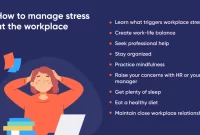Workplace challenges can often arise unexpectedly, making it essential for employees to be equipped with the necessary tools and strategies to navigate through them successfully. In this guide, we will provide valuable insights and practical advice to help employees effectively overcome the obstacles they may encounter in the workplace.
Dealing with Conflict in the Workplace
Conflict in the workplace is inevitable and can arise from various sources such as differences in opinions, values, or work styles. It is essential for employees to learn effective strategies for navigating and resolving conflicts to maintain a healthy and productive work environment.
1. Communication and Active Listening
Open and honest communication is key to resolving conflicts. Express your concerns or perspectives clearly and respectfully, while actively listening to others without interrupting. This promotes understanding and fosters constructive dialogue.
2. Seek a Middle Ground
When conflicts arise, aim for a compromise or find common ground that satisfies both parties. Collaborate to find solutions that benefit everyone involved, rather than insisting on personal preferences or positions.
3. Remain Calm and Objective
During conflicts, it is crucial to stay calm and avoid responding impulsively. Emotions can escalate tensions and hinder resolution. Instead, approach disagreements objectively by focusing on the facts and seeking solutions based on rationality and logic.
4. Collaborative Problem Solving
Work together with colleagues involved in the conflict to identify the root causes and brainstorm possible solutions. By involving all parties in the problem-solving process, you create a sense of ownership and increase the likelihood of finding mutually beneficial resolutions.
5. Respect Differences
Recognize and appreciate diversity in the workplace, including different perspectives, backgrounds, and approaches. Respect for individual differences encourages a positive and inclusive work atmosphere, reducing the chances of conflicts arising.
6. Mediation or Seeking Help
If a conflict persists or escalates despite your efforts, consider involving a neutral third party, such as a supervisor or HR representative, to mediate the situation. Their objective viewpoint and conflict resolution skills can support finding a satisfactory resolution.
In conclusion,
Conflict is a natural part of the workplace, but by using effective communication, seeking compromises, staying calm and objective, collaborative problem-solving, respecting differences, and seeking help when necessary, employees can navigate and resolve conflicts, fostering a harmonious and productive work environment.
Managing Stress and Burnout
Workplace challenges can often lead to stress and burnout among employees. It is crucial to find effective ways to manage and prioritize your well-being to maintain a healthy work-life balance.
One important step in managing stress is to identify the source of your stress. Is it a heavy workload, conflicts with colleagues, or lack of support? Once you identify the source, you can devise strategies to address it.
It is essential to establish boundaries between work and personal life. Set reasonable goals and learn to say no when necessary. Taking breaks and finding time for hobbies and relaxation can also help reduce stress levels.
Effective communication is key when dealing with workplace challenges. It is important to express your concerns and needs to your supervisor or HR department. Working together to find solutions can alleviate stress and prevent burnout.
Seeking support from colleagues or joining support groups can provide a valuable network to share experiences and gain insights into managing workplace challenges. Additionally, practicing self-care through exercise, a healthy diet, and sufficient sleep can contribute to better stress management.
In conclusion, managing stress and burnout in the workplace is crucial for maintaining well-being and productivity. By identifying stressors, setting boundaries, communicating effectively, seeking support, and practicing self-care, employees can navigate workplace challenges more effectively and lead a healthier work life.
Enhancing Resilience in the Face of Challenges
In today’s dynamic and ever-evolving work environment, employees are often faced with various challenges that can impact their professional growth and overall well-being. From internal conflicts to external pressures, navigating workplace challenges requires resilience. Here are some strategies to enhance resilience and effectively overcome obstacles:
-
Develop a Growth Mindset:
Adopting a growth mindset enables individuals to view challenges as learning opportunities. Embrace the mindset that skills can be developed and obstacles can be overcome through determination and effort.
-
Cultivate Strong Support Systems:
Building relationships with colleagues, mentors, and a supportive network is essential. Seek advice, guidance, and encouragement from trusted individuals who can provide valuable insights during challenging times.
-
Practice Self-Care:
Investing in self-care is crucial for maintaining resilience. Prioritize activities that promote physical and mental well-being, such as regular exercise, sufficient rest, and engaging in hobbies or activities that bring joy.
-
Develop Effective Coping Mechanisms:
Identify healthy coping strategies that help manage stress and adversity. This may include deep breathing exercises, mindfulness techniques, or seeking professional help when needed.
-
Set Realistic Goals:
Breaking down larger goals into smaller, manageable tasks can make challenges seem less overwhelming. By setting achievable objectives, employees can track their progress and celebrate small victories along the way.
-
Continual Learning and Adaptation:
Embrace a mindset of constant learning and adaptability. Being open to acquiring new skills and knowledge allows individuals to navigate and embrace change, even in the face of difficult situations.
Conclusion
In today’s diverse and fast-paced workplaces, employees are bound to encounter various challenges. However, with the right mindset and strategies, these challenges can be navigated effectively. By maintaining open communication, seeking support from colleagues and superiors, and continuously developing skills, employees can overcome obstacles and thrive in their careers.




